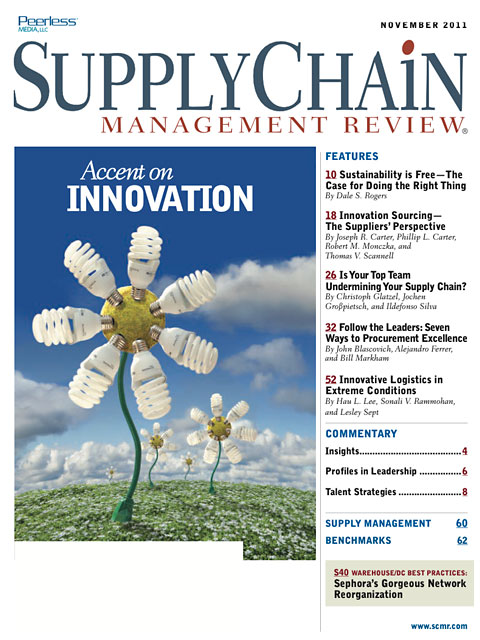Sorry, but your login has failed. Please recheck your login information and resubmit. If your subscription has expired, renew here.
November 2011
Innovation. It’s a hard competency to come by. Can schools teach you to be innovative? Is work experience really the only way to open your eyes to what’s possible? Or is the innovative spark something that lurks in an individual’s DNA—and you either have it or you don’t? Innovation. It’s a hard competency to come by. Can schools teach you to be innovative? Is work experience really the only way to open your eyes to what’s possible? Or is the innovative spark something that lurks in an individual’s DNA—and you either have it or you don’t? Innovation has worked in the Gambia situation and in supplier sourcing. Surely, there must be… Browse this issue archive.Need Help? Contact customer service 847-559-7581 More options
A.T. Kearney’s 2011 Assessment of Excellence in Procurement (AEP) study finds corporate procurement functions becoming a more vital, strategic corporate player. In the past three years, 90 percent of study participants—procurement and supply management executives from more than 185 leading companies across 32 different industries—have increased procurement’s role in developing and executing business strategies. At the same time, procurement leaders are extracting more benefits and using better governance to improve performance both internally and externally.
The findings are clear: Procurement has greater stature, more influence, and a wider reach than ever before.
When the AEP Study began back in 1992, procurement was primarily a back-office function—dealing with requisitions, bidding, order placement, receiving, and placement. Steadily, over the years, procurement has shifted resources toward activities that add value to the company, with nearly three-quarters of staff members now devoted to strategic activities. Procurement has also moved up the organizational ladder with nearly two-thirds of procurement functions reporting to a C-level executive today.
 |
This complete article is available to subscribers
only. Click on Log In Now at the top of this article for full access. Or, Start your PLUS+ subscription for instant access. |
Not ready to subscribe, but need this article?
Buy the complete article now. Only $20.00. Instant PDF Download.
Access the complete issue of Supply Chain Management Review magazine featuring
this article including every word, chart and table exactly as it appeared in the magazine.
SC
MR
Sorry, but your login has failed. Please recheck your login information and resubmit. If your subscription has expired, renew here.
November 2011
Innovation. It’s a hard competency to come by. Can schools teach you to be innovative? Is work experience really the only way to open your eyes to what’s possible? Or is the innovative spark something that lurks… Browse this issue archive. Download a PDF file of the November 2011 issue.
 |
Download Article PDF |
A.T. Kearney’s 2011 Assessment of Excellence in Procurement (AEP) study finds corporate procurement functions becoming a more vital, strategic corporate player. In the past three years, 90 percent of study participants—procurement and supply management executives from more than 185 leading companies across 32 different industries—have increased procurement’s role in developing and executing business strategies. At the same time, procurement leaders are extracting more benefits and using better governance to improve performance both internally and externally.
The findings are clear: Procurement has greater stature, more influence, and a wider reach than ever before.
When the AEP Study began back in 1992, procurement was primarily a back-office function—dealing with requisitions, bidding, order placement, receiving, and placement. Steadily, over the years, procurement has shifted resources toward activities that add value to the company, with nearly three-quarters of staff members now devoted to strategic activities. Procurement has also moved up the organizational ladder with nearly two-thirds of procurement functions reporting to a C-level executive today.
 |
SUBSCRIBERS: Click here to download PDF of the full article. |
SC
MR

Latest Supply Chain News
- How CPG brands can deliver on supplier diversity promises
- How S&OP provides the answer to in-demand products
- AI, virtual reality is bringing experiential learning into the modern age
- Humanoid robots’ place in an intralogistics smart robot strategy
- Tips for CIOs to overcome technology talent acquisition troubles
- More News
Latest Podcast

 Explore
Explore
Latest Supply Chain News
- How CPG brands can deliver on supplier diversity promises
- How S&OP provides the answer to in-demand products
- AI, virtual reality is bringing experiential learning into the modern age
- Humanoid robots’ place in an intralogistics smart robot strategy
- Tips for CIOs to overcome technology talent acquisition troubles
- There is still work to do to achieve supply chain stability
- More latest news
Latest Resources

Subscribe

Supply Chain Management Review delivers the best industry content.

Editors’ Picks





